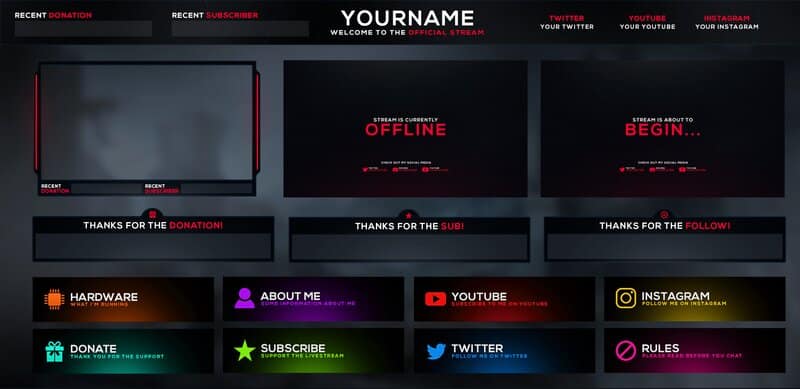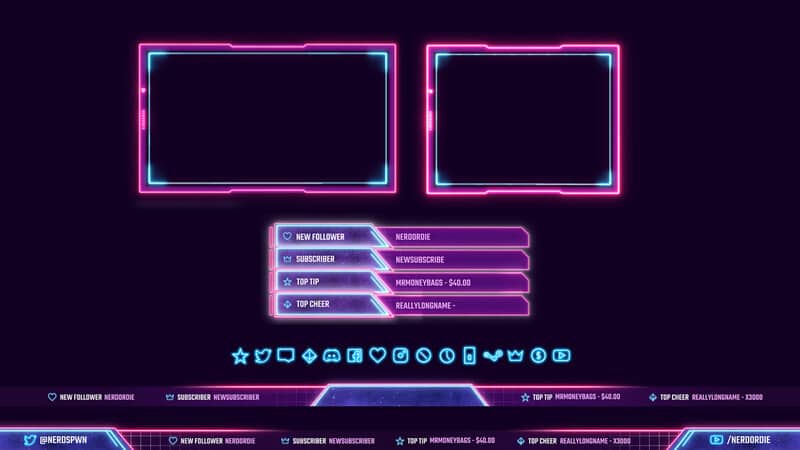Once you grasp the fundamentals of streaming and begin to attract more followers, you’ll start to consider branding more seriously. Every streamer’s goal is to establish a recognizable channel, and various graphics can assist with that.
Key Takeaway
However, before you begin designing overlays, banners, or panels, you should familiarize yourself with Twitch graphic sizes.
Every graphic has specific recommended or preferable dimensions, and this time, I would like to focus on the size of Twitch overlays.
Table of Contents
Fundamentals of Twitch Overlay
To begin with, let’s concentrate on some fundamentals before we delve deeper into stream overlay size.
To learn how to design the ideal Twitch overlay, you must first understand what a stream overlay is and its purpose.

What is a stream overlay?
Overlays are graphics positioned over the stream.
They can be either animated or static—this choice is entirely yours. Many streamers prefer animated graphics because they capture viewers’ attention, while for others, static overlays align better with their brand.
An overlay should emphasize key elements of the stream. For instance, the most frequently used overlay is the webcam overlay.
It is simply a banner that surrounds the webcam video.
Additionally, you can have an overlay for the chatbox, alerts, donations, or other widgets you utilize during the stream.
Depending on your needs, the overlay can include multiple elements or be very simple.
Do I need it?
Yes, even if you are a beginner with few followers and views, you should use overlays.
Even a simple graphic can make your stream appear more entertaining and professional. The goal is to enhance the streaming experience and gain more followers.
Additionally, it will assist with branding.
By utilizing somewhat similar graphics (theme or style), your channel will distinguish itself from others. When a newcomer discovers your stream, they will notice a sense of consistency throughout your channel.
How to Create a Twitch Overlay?
I prefer custom overlays. When you create the overlay, you can select the elements you need, along with a theme that complements your channel and the game you are streaming.
Since not every streamer is a skilled designer or possesses exceptional Photoshop abilities, there are several websites available for custom overlays.
You have the freedom to choose the style, select the template, and then customize it to align with your brand.
My two preferred websites for Twitch overlays are:
Both websites offer an extensive library of templates, and the editing process is straightforward. Some templates are available for free, so you don’t need to spend any money on graphics. For premium members, the options are limitless, and all prices are affordable.
Here is a list of additional websites for overlay templates:
If you are willing to invest a bit more in an overlay, you can hire a professional designer. Many specialize in creating Twitch overlays, understand various themes, and can produce unique, eye-catching graphics for your channel.
When designing, you should take into account a few additional factors:
Twitch Overlay Size
There are two Twitch overlay dimensions: one for the facecam overlay and the other for the stream overlay.
I would like to point out that the specified sizes are recommended and represent the maximum dimensions for both types of overlays; however, you may use even smaller dimensions.

Stream Overlay
For streaming, the recommended size is 1920×1080 pixels or a 16:9 aspect ratio.
It is easy to identify mistakes, and incorrect stream overlay dimensions can negatively affect the quality of the stream.
My top tip for designing the stream overlay is to maintain a clean look—avoid using too many different elements and ensure the theme is consistent. This approach will enhance the streaming experience for viewers.
The file format must be either PNG or WEBM; the former is for static overlays, while the latter is for animations.
Webcam Overlay
Designing a webcam overlay can be somewhat challenging, particularly when it comes to determining the dimensions.
Streamers usually use webcam videos, which are often resized or cropped. You may also notice that some employ masks because they prefer not to use the default shape of the facecam.
The webcam overlay will be slightly smaller than the stream overlay, measuring 1600×1200 pixels. This dimension is applicable to the 4:3 frame. While some streamers prefer the 16:9 ratio, the choice largely depends on the quality of the recording, the resolution of your camera, and your personal preferences.
Twitch will accept both PNG and WEBM file formats.
If you are using a static overlay, save the file as a PNG (ensure it is a transparent PNG). Streamers who prefer animated overlays should use the WEBM file format.
GIFs are also supported by Twitch; however, you may encounter issues with file size, as they tend to be larger and could affect the quality of the stream.
As you can see, a well-designed webcam overlay results from trial and error.
Although templates can be beneficial, you will need to adjust sizes, cropping, and masks to achieve the best results.
Related: Twitch Panels Size – The Best Size for Twitch Panels
Frequently Asked Questions
What size should Twitch panels be?
The best size of the Twitch panel is 320×160 pixels. Twitch has a fixed width of the panels, so you cannot go above 320, but the height can be changed as desired.
What is the size of the gaming overlay?
The recommended size of gaming overlay is 1920×1080 pixels, and the file format should be either PNG or WEBM. You don’t have to stick to that size of the overlay – smaller ones can be used as well. This depends mostly on the design you have in mind, as well as the number of elements you want to use. Also, before adding the overlay, scan each element carefully. This is a large overlay, and it will be easy for anyone to spot the mistakes.
What size should a cam overlay be?
For webcam, the recommended dimension is 1600×1200 pixels, or 4:3 and 16:9 frames. However, sticking to these recommendations is tricky, especially if you have already done some resizing of the webcam or cropping. While designing, try out a few different dimensions, to see which suits them best.
